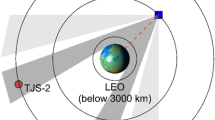Abstract
China completed a basic COMPASS navigation network with three Geostationary and three Inclined Geosynchronous satellites in orbit in April 2011. The network has been able to provide preliminary positioning and navigation functions. We first present a quality analysis using 1-week COMPASS measurements collected in Wuhan. Satellite visibility and validity of measurements, carrier-to-noise density ratio and code noise are analyzed. The analysis of multipath combinations shows that the noise level of COMPASS code measurements is higher than that of GPS collected using the same receiver. Second, the results of positioning are presented and analyzed. For the standalone COMPASS solutions, an accuracy of 20 m can be achieved. An accuracy of 3.0 m for the vertical, 1.5 m for the North and about 0.6–0.8 m for the East component is obtained using dual-frequency code only measurements for a short baseline. More importantly, code and phase measurements of the short baseline are processed together to obtain precise relative positioning. Kinematic solutions are then compared with the ground truth. The precision of COMPASS only solutions is better than 2 cm for the North component and 4 cm for the vertical. The standard deviation of the East component is smaller than 1 cm, which is even better than that of the East component of GPS solutions. The accuracy of GPS/COMPASS combination solutions is at least 20 % better than that of GPS alone. Furthermore, the geometry-based residuals of double differenced phase and code measurements are analyzed. The analysis shows that the noise level of un-differenced phase measurements is about 2–4 mm on both B1 and B2 frequencies. For the code measurements, the noise level is less than 0.45 m for B1 CA and about 0.35 m for B2 P code. Many of the COMPASS results presented are very promising and have been obtained for the first time.

























Similar content being viewed by others
References
Amiri-Simkooei AR, Tiberius CCJM (2007) Assessing receiver noise using GPS short baseline time series. GPS Solut 11(1):21–35
Cao C, Jing G, Luo M (2008a) COMPASS satellite navigation system development. PNT challenges and opportunities symposium, Stanford, California, USA, 5–6 Nov 2008
Cao W, O’Keefe K, Cannon ME (2008b) Evaluation of COMPASS ambiguity resolution performance using geometric-based techniques with comparison to GPS and Galileo. ION GNSS 2008, Session B4, Savannah, Georgia, USA, 16–19 Sept 2008
Chang XW, Yang X, Zhou T (2005) MLAMBDA: a modified LAMBDA method for integer least-squares estimation. J Geodesy 79:552–565. doi:10.1007/s00190-005-0004-x
De Wilde W, Boon F, Sleewaegen JM, Wilms F (2007) More COMPASS points—tracking China’s MEO satellite on a hardware receiver. Inside GNSS 2(5):44–48
Gao G, Chan A, Lo S, De Lorenzo D, Walter T, Enge P (2009) COMPASS-M1 broadcast codes in E2, E5b and E6 frequency bands. IEEE J Sel Top Signal Process 3(4):599–612
Greilier T, Dantepal J, Delatour A, Ghion A, Enge P (2007a) Initial observations and analysis of COMPASS MEO satellite signal. Inside GNSS 2(4):39–43
Greilier T, Ghion A, Dantepal J, Ries L, Delatour A, Avila-Rodriguez JA, Wallner S, Hein GW (2007b) COMPASS signal structure and first measurements. In: Proceedings of the international technical meeting of the institute of navigation, ION-GNSS 2007, 25–28 September, 2007, Fort Worth, Texas
Hauschild A, Montenbruck O, Sleewaegen JM, Huisman L, Teunissen PJG (2011) Characterization of COMPASS M-1 signals. GPS Solut. doi:10.1007/s10291-011-0210-3
Liu Z (2011) A new automated cycle slip detection and repair method for a single dual-frequency GPS receiver. J Geodesy 85(3):171–183. doi:10.1007/s00190-010-0426-y
Liu J, Ge M (2003) PANDA software and its preliminary result of positioning and orbit determination. J Nat Sci Wuhan Univ 8(2B):603–609, doi:10.1007/BF02899825
Ran C (2010) COMPASS satellite system development and plan. The first China satellite navigation conference, Beijing, May 19–21, 2010
Septentrio (2010) Septentrio reports frequency spikes in compass M1 satellite signals, http://www.insidegnss.com/node/2061
Shi C, Zhao Q, Geng J, Lou Y, Ge M, Liu J (2008) Recent development of PANDA software in GNSS data processing. In: Proceedings of the society of photographic instrumentation engineers, 7285, 72851S, doi:10.1117/12.816261
Teunissen PJG (1993) Least-squares estimation of the integer GPS ambiguities. Invited lecture, Section IV “Theory and methodology”, IAG, Beijing, China, August
Tiberius C, Kenselaar F (2000) Estimation of the stochastic model for GPS code and phase observables. Surv Rev 35(277):441–454
Tiberius C, Kenselaar F (2003) Variance component estimation and precise GPS positioning: case study. J Surv Eng 129(1):11–18. doi:10.106/(ASCE)0733-9453(2003)129:1(11)
Unicore (2010) Installation and operation user manual: UB240-CORS Beidou/GPS dual-system dual-frequency high precision receiver
Verhagen S, Joosten P (2003). Algorithms for design computations for integrated GPS-Galileo. GNSS 2003, The European navigation conference, 22–25 April 2003, Graz, Austria
Zhang S, Guo J, Li B, Rizos C (2011). An analysis of satellite visibility and relative positioning precision of COMPASS. In: Symposium for Chinese professionals in GPS, Shanghai, People’s Republic of China, 18–20 August, pp 41–46
Acknowledgments
This work is supported by the National Nature Science Foundation of China (No: 40874004), the National “863 Program” of China (No: 2009AA121401) and the “111 Project” of China (No: B07037). The authors are thankful to Dr. X. Liu, who considerably revised and smoothed the manuscript. The authors are also grateful for the comments by the editor and two reviewers, which helped us to improve our manuscript significantly.
Author information
Authors and Affiliations
Corresponding authors
Rights and permissions
About this article
Cite this article
Shi, C., Zhao, Q., Hu, Z. et al. Precise relative positioning using real tracking data from COMPASS GEO and IGSO satellites. GPS Solut 17, 103–119 (2013). https://doi.org/10.1007/s10291-012-0264-x
Received:
Accepted:
Published:
Issue Date:
DOI: https://doi.org/10.1007/s10291-012-0264-x




